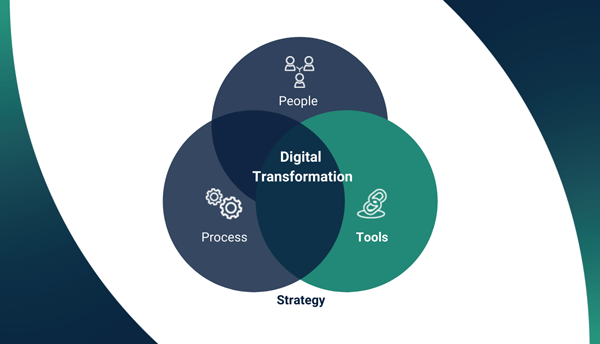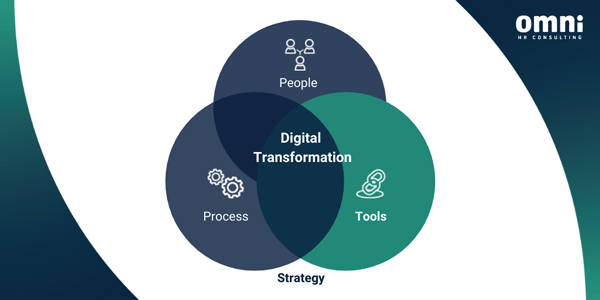Digital Transformation: A CtO Perspective
Part 2 - Who led Digital Transformation in your organisation?
"DTS is the integration of digital technology into almost all aspects of a business; fundamentally changing how you operate and deliver value to customers or service them."
- David Londt-
Who led Digital Transformation within your Organisation?
A: COVID-19
B: Chief Technology Officer (CTO) or
C: Chief Executive Officer (CEO)
Introducing David Londt, National IT Manager at Omni HR Consulting
As the IT Manager at Omni, it is my responsibility to ensure that everything that has to do with ICT is readily available to everyone in our organisation. I need to ensure that our systems are always up and functioning at 100%.
If we require or need anything innovative from a technology perspective that will help us achieve our goals, I do the research and find a tool that is able to help us achieve that. IT Managers these days have a little bit of everything in their roles - we are not just about information technology! We are responsible to ensure functionality and stay abreast of all things digital out there.
Q: In terms of our topic which addresses, Digital Transformation – from your perspective, how much does Digital Transformation have to do with technology?
DL: If you look at Digital Transformation Strategies (DTS), there is no single technology that will deliver speed or innovation as such. The best combination of tools for a given organisation will vary from one (company) vision to another.
Digital Transformation can involve many different technologies and there are so many out there right now. The biggest ones are; Cloud Computing, the Internet of Things (IoT), Artificial Intelligence (AI) and Big Data. DTS It is not only about technology; change in business processes and corporate culture are just as vital or important to the success of these initiatives. Technologies like Big Data, Cloud, IoT and AI are helping companies develop new business models and disrupt the established way of running any operation.
Q: In order to demystify the term: Digital Transformation Strategies; how would you define it from your perspective?
DL: DTS is the integration of digital technology into almost all aspects of a business; fundamentally changing how you operate and deliver value to customers or service them. It is also a cultural change that requires organisations’ to continue to change their existing way of doing things; it is also about experimenting and getting comfortable with failure as well.
DTS has its ups and downs and the only thing you can do is to learn from your mistakes and get stronger from there. DTS will look different for every business, it can be hard to pinpoint one definition that applies to all organisations. The idea is to use technology not just to replicate an existing service in a digital format but to use technology to transform service into something exponentially better.
Q: Identifying that DTS is centred around adding value to your customer – is this both from an internal and external customer perspective?
DL: You absolutely must look at both! You can’t just look at implementing DTS for external clients, you have to consider internal stakeholders as well. Your employees/staff are customers, so any platforms you consider using or developing needs to create value. Take e-Learning for example; it is an external product, however, employees (internally) will utilize for self/skills development.
Q: Based on the COVID-19 pandemic, has your I.T Agenda shifted in terms of priorities or goals from a Digital Transformation perspective?
DL: As I always say to everyone; when I initially set up the I.T. infrastructure at Omni, I set it up in such a way, that you could be anywhere in the world and still do your job, fully functional. I always joke that you could sit on the moon and if you get a signal you would be able to carry on working, delivering on everything that you need to.
There wasn’t much that I needed to change as the infrastructure we have in place allowed us as an organisation to continue operating. I think the biggest fear that a lot of I.T Managers have these days is Cyber-Security. You have a larger percentage of your workforce working remotely now so, ensuring that, any remote services you are giving your employees access to is locked down and secure and that encryption levels on data are set. You need a whole new mindset of looking at things.
With the lockdown, it has opened doors for more cyber-attacks. Cyber-hackers are looking for weak spots and with employees working from home, one cannot be sure of their security setup, the kind of routers they have or if their passwords on their routers are equivalent to what we as I.T Managers try and force in the business.
COVID-19 and the lockdown make us IT people worry a bit – however, I am confident that all our systems are secure and locked down. We can continue functioning remotely for some time to come.
Q: As you have said, many I.T Managers may be concerned during this time. Is there any advice that you would give IT Managers to make the mind-shift especially for those still battling with the concept to feel comfortable with implementing remote work?
DL: Well as I said before, with remote work, you just need to make sure that you are giving employees access to the servers that you have whether it be on-premises or in the cloud. Make sure that your security levels are up to scratch and plug any holes in your security layers that might open you up to an attack. We all know that systems are never 100% secure. There is always someone out there that will try and find a way in.
From an Omni point of view, we are all able to carry on working remotely. From our R&D team, Marketing, Web Developers, I.T and even Facilitators; we just had to change the way we did things. One of our core functions is training and with no more face-to-face training, all engagements are going onto a digital platform together with our e-Learning. The same goes for meetings or conferences; we are all attending them digitally, whether it’s using Skype, Zoom or Microsoft Teams.
Microsoft Teams is having a big impact on the way people are working these days. There is a lot of technology out there and when you are implementing something, just make sure it is secure.
Contributor: David Londt, IT Manager, Omni HR Consulting
Additional recommended reading:
1. 6 Steps Framework to implement Digital Transformation in Business: New Generation Apps
2. Unlocking success in Digital Transformations: McKinsey and Company
3. How to develop a Digital Transformation Strategy: MediumRelated Posts
Having discovered our motivation (“Why”), and laid out core principles (“How”), we finally turn to “What” we do and how it translates into business success.
Most companies and people know “how” they do what they do. A carpenter knows how to sand wood. Similarly, a company knows how it sells its product. The “How” …
Personally, I do not believe that the traditional approach to training and development will support long-term future sustainability for either the Skills…





















